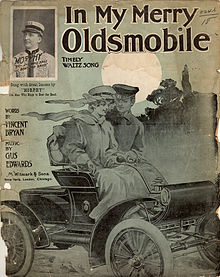In My Merry Oldsmobile
In My Merry Oldsmobile is a pop song written by Gus Edwards (music) and Vincent P. Bryan (lyrics) and published in 1905. In My Merry Oldsmobile was the most popular automobile song of its time and is considered to pave the way for many later songs about the automobile , such as (Get Your Kicks On) Route 66 by Bobby Troup (1946).
background
For promotional purposes, Ransom Eli Olds , owner of the Oldsmobile car brand , drove two of his vehicles to the Lewis & Clark Centennial Exposition in Seattle from April to June 1905 . Because this trip was very adventurous and the American press reported about it, this tour inspired the songwriter tram Bryan / Edwards to write the waltz In My Merry Oldsmobile . The song begins with the lines:
- Young Johnny Steele has an Oldsmobile
- He loves his dear little girl
- She is the queen of his gas machine
- She has his heart in a whirl.
Vincent Bryan's text is in the form of a marriage proposal (in which Johnny promises his bride to take her to the church where he would marry her); but is also full of sexual hints ( Each day they "spoon" to the engine's tune , They love to "spark" in the dark old park and you can go as far as you like with me ) and conjures up the wishes of young people: freedom of driving and freeing young people from parental supervision.
- Down the road we'll fly
- Automobubbling you and I.
First recordings and later cover versions
The musicians who were the first to cover the song included Billy Murray (Victor 4467), Arthur Collins (Concert 7617) (circa 1907) and Henry Burr (1905, Columbia 91000). The Jean Goldkette Orchestra recorded In My Merry Oldsmobile for Victor in 1927; the record was distributed by General Motors at the Detroit Auto Show that same year . Bill Challis wrote the arrangement ; The soloist was Bix Beiderbecke . The song was also used in a promotional cartoon for the Fleischer Brothers of Oldsmobile (1931). The line You can go as far as you like with me in my merry Oldsmobile became a company's advertising slogan.
The discographer Tom Lord lists a total of 16 (as of 2015) cover versions in the field of jazz , including a. by Les Brown , Ray McKinley , Tex Beneke , Butch Stone / Van Alexander , Phil Napoleon , Gerald Wiggins and The Kings of Dixieland . Bing Crosby interpreted the song in the film The Star Maker (1939, director: Roy Del Ruth , recording Decca 2700). The song was also used in a biography of Gus Edwards (1939).
In Great Britain, the BBC boycotted the song in 1962 on the grounds:
- “We have nothing against the song. However, one should consider where this can lead. Soon we will have a Rolls Royce concert or the Mini Minor waltz. "
Individual evidence
- ↑ a b Michael Lasser: America's Songs II: Songs from the 1890s to the Post-War Years . 2014
- ^ Diane Holloway American History in Song: Lyrics From 1900 to 1945 . 2001, p. 33
- ↑ a b Steve Sullivan: Encyclopedia of Great Popular Song Recordings, Volume 2 . 2013, p. 585.
- ^ Michael L. Berger: The Automobile in American History and Culture: A Reference Guide . 2001, p. 20.
- ↑ [1]
- ^ Jon W. Finson The Voices that Are Gone . 1997, p. 146
- ↑ Automobubbling was a strange pronunciation variant of automobile at that time . See Rosemarie Ostler: Dewdroppers, Waldos, and Slackers: A Decade-by-Decade Guide to the Vanishing 2005, p. 11.
- ↑ Murray recorded other songs besides My Merry Oldsmobile for promotional purposes, such as Budweiser's a Friend of Mine (Victor 16049), with the Hayden Quartet the song Come Josephine in My Flying Machine . See Just Remember This by Colin Bratkovich, 2014, p. 25.
- ^ Diane Holloway: American History in Song: Lyrics From 1900 to 1945 , 2001, p. 33.
- ↑ Tom Lord: Jazz discography (online)
- ^ A b David L. Lewis: The Public Image of Henry Ford: An American Folk Hero and His Company . 1976

